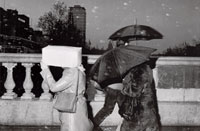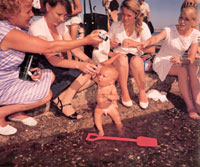The Story Of The Blues
| |
 Autoportrait, Cuba. |
Phaidon continue to come up trumps with photography books. Their fabulous 55 series goes from strength to strength, and hot on the heels of the excellent Nick Waplington Truth Or Consequences, Roy DeCarava's The Sound I Saw and the exhaustive Robert Cappa retrospective comes Val Williams' wonderful in-depth look at the work of Martin Parr. Parr is possibly the UK's most celebrated contemporary photographer, and on the evidence of this beautifully presented book, which collects images from all his published books, including The Last Resort, Signs of the Times and Think Of England, rightly so. From the early 1970s, Parr has religiously documented his world; a world largely of the North of England, often specifically Manchester, a world of mainly (though by no means exclusively) what we would once have called The Working Classes, although naturally in these classless New Labour times such terms are an irrelevance, a blast from a vulgar past never to be uttered. For the past thirty years Martin Parr has been, quite simply, a dedicated, incredibly observant, sympathetic curator of a museum of a living, breathing, ever changing Modern Britain. Others of course would pretend that they have created their own museums of Britain's post war history, would make a case for having presented that development through visual media. Mostly, of course, they would be wrong, would simply be guilty of producing retro-TV and magazine articles where the same old faces and artefacts are dragged into the light to cement some sort of false collective memory. So that there's is the mythology of The Avengers, Swinging Britain, mini-skirts, The Beatles, safety pins in ears, The Sex Pistols, new romantics, Ecstasy, The Spice Girls... a mythology based on some warped collective love for The Clangers and Space Hoppers. Parr seems however, through his own work and his obsessive collecting and collation of other visual sources, to be determined to document a different Modern Britain to that popularised by retro-TV; his is a Britain that many would prefer to pretend didn't, and doesn't exist. It's the England of concrete town centre shopping arcades and council housing tower blocks, of bus terminals and rail-side office buildings, standing quietly in the rain, evidenced nowhere more eloquently than in his collection of Boring Postcards (also published by Phaidon - and for an intriguing follow up to that book, you ought to check out this site, where one dedicated fan aims to photograph all the sites in the book as they stand today). And what's so interesting, for me at least, is the way that Parr's photographs make the UK of the 1970s, 1980s and to a slightly lesser degree the 1990s seem like a third world country; how his photographs puncture the whole myth of collective histories and make those histories instead evidently human and individual. |
 Dublin, 1981, from Bad Weather. |
Parr seems fascinated by the meaning of images; the very essence of the meaning communicated by events or objects that we experience visually, and the idea that those meanings can be manipulated by altering the context, notably by taking them from the world and presenting them as still images in a gallery or a book. Nowhere is this more evident that in his 'Autoportrait' series. Here, Parr has himself photographed in Studios around the world, so that for example we have him in hand-tinted '50s style from Havana, peering through the gaping jaws of a painted shark in Benidorm, soberly seated at a book in what might appropriately be a psycho-analysists room in Vienna, and most bizarrely of all, morphed onto the bulging torso of a bodybuilder from New York. These Autoportraits are of course Parr having a laugh, but it's a joke with a purpose, a gag with meaning; the meaning being that this is what photography is all about: illusion. The Autoportraits say; where is the real Martin Parr? Who is the real Martin Parr? What he's doing, essentially, is telling it like it is: we need to think about what we see; we need to think about the world we move through, if we want to find our truths and our realities, want to find our true selves. His photos of his collections of commercial promotional items like wallpaper and sweets, in particular the Walkers Crisps packets with the Spice Girls packaging, are also excellent. As critiques of rampant mediated personality, and, in the case of the Spice Girls in particular, the very lack of real personality, and the celebration of ordinariness are sharply eloquent. These photos speak of the very lack of the extra-ordinary in much of contemporary popular culture; a kind of strange democratisation of fame, where stardom is diluted by the transparent contradictions inherent in lottery-culture shows like Pop Idol and Popstars: it could be you, even though you know damn well it wont be, cant be. And of course the Stars are just like us... ordinary people. They eat Walkers crisps too. How disappointing. And that's something, thankfully, you could never say of the photographs of Martin Parr. |
 Four Women and Naked Baby - New Brighton, Merseyside, England. 1985. |
The Autoportraits and photos of artefacts however, despite their importance for holding the key for reading the other photographs, are merely the supporting cast, and it's the images of such subjects as women in a Salford hairdressers or perusing brochures at a Lingerie party, or families collected in Merseyside's New Brighton, enjoying the summer sun amidst squalor and decay that are the real body of the book, and the real interest. These photographs seem, to me at least (which means I'm inevitably projecting) to be loaded with what is essentially a Middle Class sense of disappointment with much of the world; specifically the Working Class world. They seem to be loaded with that kind of peculiarly British Middle Class guilt where there is a strange deep-seated faith in socialist ideals tempered with a very real rejection of and repulsion from Working Class social mores. I can't help but see a real sense of wishing in many of Parr's photographs; a desire to see real hope and worth in, for example, the garish, run-down, litter-strewn world of New Brighton, but in fact seeing only desolation, sadness, vulgarity, a spiral of poverty and filth. This is of course wildly political documentation, being a critique on political and social structures that fail people; that set up systems which are designed only to allow these people to fail. So in the end the images are not about the failures of the people pictured but rather of those unseen. It's like the Blues, and how in the Blues it's what is unsaid that is more important than what is said; how the meaning is in what lies behind the words, rather than the words themselves. Only here the meaning is in what lies behind the image. So in a sense, Parr's photographs are a visual, British version of the Blues, Parr a contemporary Robert Johnson using a camera as his voice. Or at the very least, a sidekick to Pete Wylie, singing his very own 'Story Of The Blues'. © Alistair Fitchett 2002 Martin Parr is published by Phaidon books (ISBN: 0 7148 3990 6) and costs £45.00 An exhibition, Martin Parr: Photographics Works, also selected by Val Williams, runs at the Barbican Art Gallery, London, until 14th April 2002. |